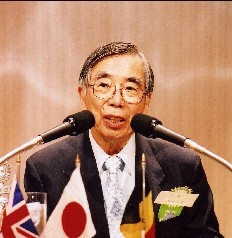��Environmental Protection Month�� Meeting
��Measures for Global Warming��
May17, 2006
Mr. Yoichi Kaya,
Vice Director in General and Laboratory Director,
Research Institute of Innovative Technology for the Earth
 ��Data for the last one hundred and forty years indicates that the earth��s surface temperature has been sharply rising for the current one hundred years.��
��Data for the last one hundred and forty years indicates that the earth��s surface temperature has been sharply rising for the current one hundred years.��
��Research data for temperature rises in the north hemisphere for the last 1000 years extrapolated from the annual rings of a tree also show the similar result.
��According to the recent report released by IPCC (Intergovernmental Panel for Climate Change), an international organization, it is predicted that the ��global average temperature will rise 1.4 to 5.8 degrees Celsius by the end of this century, and sea levels will also rise 0.09 to 0.88 meters.��
��The first concrete example influenced by the foregoing is the change in the ocean current thermohaline circulation phenomenon. As global warming progresses, ice will melt in the north, and it will cause more rainfall. If rain falls on the sea, the salinity on the ocean��s surface will decrease. In other words, ocean currents will become lighter and it will not sink down, and the thermohaline circulation will temporarily pause. We should admit that there is actually a danger that the pace of thermohaline circulation will gradually slow down and finally come to a stop.
��The second example is the change in ice piled up on the surface of Greenland.
��Currently, the amount of snowfall and ice-melting are in balance. As the temperature rises, the amount of melting ice will increase, and the ice sheet will gradually decrease. Water in the sea will increase by just that much.
��Calculation is made what will happen if all ice sheets melt down. Such a calculation revealed an incredible result. It is predicted that the sea level will go up 7 meters.
��Set up in the Kyoto Protocol formulated in December 1997 was a target ��to reduce greenhouse gas emissions by 5.2 percent on average by 2010��. The protocol took effect in February last year, but there are two problems. One is that since the number of participating countries is fewer than initially anticipated, the participants�� total GHG emissions are only thirty percent of the worldwide emissions. The other is that the target achievement by entire participating countries (including Japan) can hardly be expected.
��What the EU is recommending as a long-term issue is to ��restrain the average temperature rise to 2 degrees Celsius in comparison with the temperature before the Industrial Revolution.��
��The Earth��s surface temperature has already risen 0.7 degrees Celsius since the Industrial Revolution. Besides, the actual effect of carbon dioxide or other greenhouse gases produced by us has not thoroughly been observed yet.
��They will begin to affect the environment during several ten years to come, resulting in a temperature rise of 1.0 degree at the highest, or 0.2 degrees at the lowest. The remaining range of the allowed temperature rise is only 0.3 degrees.
��Dr. Weiss, in Germany, attempted a calculation for the target to be achieved. According to his calculation, if only advanced nations are trying to achieve the target as currently planned, they need to reduce their greenhouse gas emissions by 70 �� 90 percent on average by 2050. The EU��s target is much more difficult to be achieved than that of the Kyoto Protocol.
��Lately emerged is a trend to make a separate effort in parallel with attempts made within a frame of the United Nations, because they are considered to have certain limitations. This is exemplified by a multinational cooperation called the ��Asia Pacific Partnership on Clean Development and Climate��, which started last year.
��This is a program participated in by six Pacific nations, the U.S., Australia, Japan, Korea, China, and India, and it is presently engaging in several works.
��Not all measures combating global warming necessarily slow down the economic activities. The best example is energy-saving efforts. Efficiency improvement in energy usage will help reduce energy costs, which will bring benefits also to the economy.
��A move toward the promotion of what we call ��non-regret measures�� is now seen among member nations of the Asia Pacific Partnership. Discussions are now being made for various areas, such as the steel and power industries, especially regarding how to enhance power generation efficiency. I think that not only the six Asia Pacific nations but also the Summit nations had better to join in this Partnership. The Summit meeting will be held in Japan in 2008.
��Russia and the EU will participate in the meeting. Don��t you think a key to the solution of these problems is the clarification made by participating nations of their attitudes toward the global warming issues? This will not contradict the current framework treaty. I believe the Japanese government also moves toward the same direction.